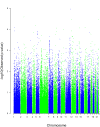Placental genome and maternal-placental genetic interactions: a genome-wide and candidate gene association study of placental abruption
- PMID: 25549360
- PMCID: PMC4280220
- DOI: 10.1371/journal.pone.0116346
Placental genome and maternal-placental genetic interactions: a genome-wide and candidate gene association study of placental abruption
Abstract
While available evidence supports the role of genetics in the pathogenesis of placental abruption (PA), PA-related placental genome variations and maternal-placental genetic interactions have not been investigated. Maternal blood and placental samples collected from participants in the Peruvian Abruptio Placentae Epidemiology study were genotyped using Illumina's Cardio-Metabochip platform. We examined 118,782 genome-wide SNPs and 333 SNPs in 32 candidate genes from mitochondrial biogenesis and oxidative phosphorylation pathways in placental DNA from 280 PA cases and 244 controls. We assessed maternal-placental interactions in the candidate gene SNPS and two imprinted regions (IGF2/H19 and C19MC). Univariate and penalized logistic regression models were fit to estimate odds ratios. We examined the combined effect of multiple SNPs on PA risk using weighted genetic risk scores (WGRS) with repeated ten-fold cross-validations. A multinomial model was used to investigate maternal-placental genetic interactions. In placental genome-wide and candidate gene analyses, no SNP was significant after false discovery rate correction. The top genome-wide association study (GWAS) hits were rs544201, rs1484464 (CTNNA2), rs4149570 (TNFRSF1A) and rs13055470 (ZNRF3) (p-values: 1.11e-05 to 3.54e-05). The top 200 SNPs of the GWAS overrepresented genes involved in cell cycle, growth and proliferation. The top candidate gene hits were rs16949118 (COX10) and rs7609948 (THRB) (p-values: 6.00e-03 and 8.19e-03). Participants in the highest quartile of WGRS based on cross-validations using SNPs selected from the GWAS and candidate gene analyses had a 8.40-fold (95% CI: 5.8-12.56) and a 4.46-fold (95% CI: 2.94-6.72) higher odds of PA compared to participants in the lowest quartile. We found maternal-placental genetic interactions on PA risk for two SNPs in PPARG (chr3:12313450 and chr3:12412978) and maternal imprinting effects for multiple SNPs in the C19MC and IGF2/H19 regions. Variations in the placental genome and interactions between maternal-placental genetic variations may contribute to PA risk. Larger studies may help advance our understanding of PA pathogenesis.
Conflict of interest statement
Figures



Similar articles
-
Circadian clock-related genetic risk scores and risk of placental abruption.Placenta. 2015 Dec;36(12):1480-6. doi: 10.1016/j.placenta.2015.10.005. Epub 2015 Oct 23. Placenta. 2015. PMID: 26515929 Free PMC article.
-
Abruptio placentae risk and genetic variations in mitochondrial biogenesis and oxidative phosphorylation: replication of a candidate gene association study.Am J Obstet Gynecol. 2018 Dec;219(6):617.e1-617.e17. doi: 10.1016/j.ajog.2018.08.042. Epub 2018 Sep 5. Am J Obstet Gynecol. 2018. PMID: 30194050 Free PMC article.
-
Genetic variations related to maternal whole blood mitochondrial DNA copy number: a genome-wide and candidate gene study.J Matern Fetal Neonatal Med. 2017 Oct;30(20):2433-2439. doi: 10.1080/14767058.2016.1252747. Epub 2017 Apr 4. J Matern Fetal Neonatal Med. 2017. PMID: 27806667 Free PMC article.
-
Genetic risk factors for placental abruption: a HuGE review and meta-analysis.Epidemiology. 2008 Mar;19(2):309-23. doi: 10.1097/EDE.0b013e3181635694. Epidemiology. 2008. PMID: 18277167 Review.
-
A Data-Driven Review of the Genetic Factors of Pregnancy Complications.Int J Mol Sci. 2020 May 11;21(9):3384. doi: 10.3390/ijms21093384. Int J Mol Sci. 2020. PMID: 32403311 Free PMC article. Review.
Cited by
-
Maternal Early Pregnancy Serum Metabolomics Profile and Abnormal Vaginal Bleeding as Predictors of Placental Abruption: A Prospective Study.PLoS One. 2016 Jun 14;11(6):e0156755. doi: 10.1371/journal.pone.0156755. eCollection 2016. PLoS One. 2016. PMID: 27300725 Free PMC article.
-
"The First Thousand Days" Define a Fetal/Neonatal Neurology Program.Front Pediatr. 2021 Aug 2;9:683138. doi: 10.3389/fped.2021.683138. eCollection 2021. Front Pediatr. 2021. PMID: 34408995 Free PMC article. Review.
-
The genomics of prematurity in an era of more precise clinical phenotyping: A review.Semin Fetal Neonatal Med. 2016 Apr;21(2):89-93. doi: 10.1016/j.siny.2016.01.001. Epub 2016 Feb 3. Semin Fetal Neonatal Med. 2016. PMID: 26851828 Free PMC article. Review.
-
Circadian clock-related genetic risk scores and risk of placental abruption.Placenta. 2015 Dec;36(12):1480-6. doi: 10.1016/j.placenta.2015.10.005. Epub 2015 Oct 23. Placenta. 2015. PMID: 26515929 Free PMC article.
-
Maternal-fetal genetic interactions, imprinting, and risk of placental abruption.J Matern Fetal Neonatal Med. 2022 Sep;35(18):3473-3482. doi: 10.1080/14767058.2020.1822314. Epub 2020 Sep 24. J Matern Fetal Neonatal Med. 2022. PMID: 32972274 Free PMC article.
References
-
- Leunen K, Hall DR, Odendaal HJ, Grove D (2003) The profile and complications of women with placental abruption and intrauterine death. J Trop Pediatr 49(4):231–234. - PubMed
-
- Odendaal HJ, Hall DR, Grove D (2000) Risk factors for and perinatal mortality of abruptio placentae in patients hospitalised for early onset severe pre-eclampsia - a case controlled study. J Obstet Gynaecol 20(4):358–364. - PubMed
-
- Naeye RL, Harkness WL, Utts J (1977) Abruptio placentae and perinatal death: a prospective study. Am J Obstet Gynecol 128(7):740–746. - PubMed
-
- Naeye RL (1980) Abruptio placentae and placenta previa: frequency, perinatal mortality, and cigarette smoking. Obstet Gynecol 55(6):701–704. - PubMed
-
- Ananth CV, Wilcox AJ (2001) Placental abruption and perinatal mortality in the United States. Am J Epidemiol 153(4):332–337. - PubMed
Publication types
MeSH terms
Substances
Grants and funding
LinkOut - more resources
Full Text Sources
Other Literature Sources
Miscellaneous

